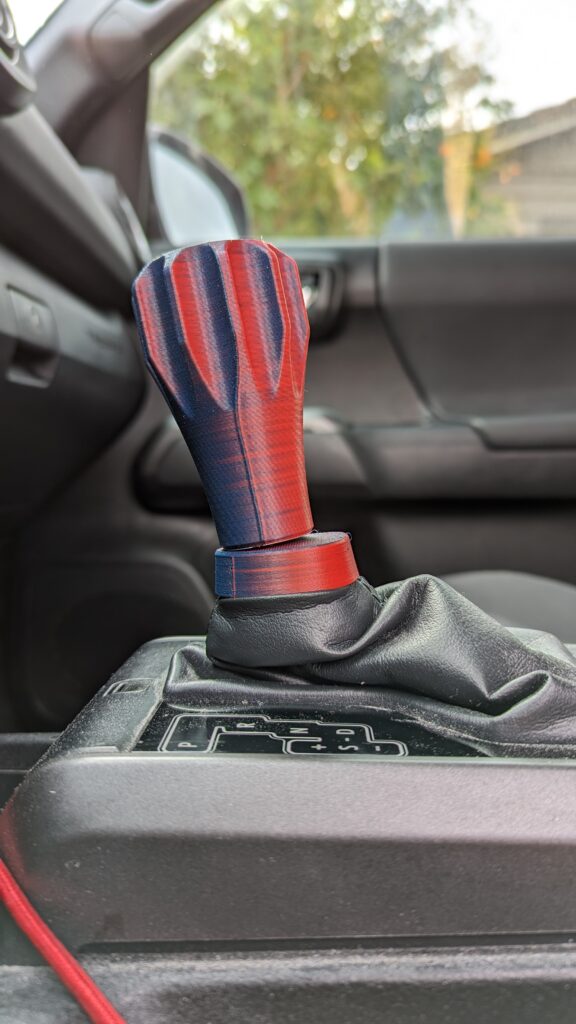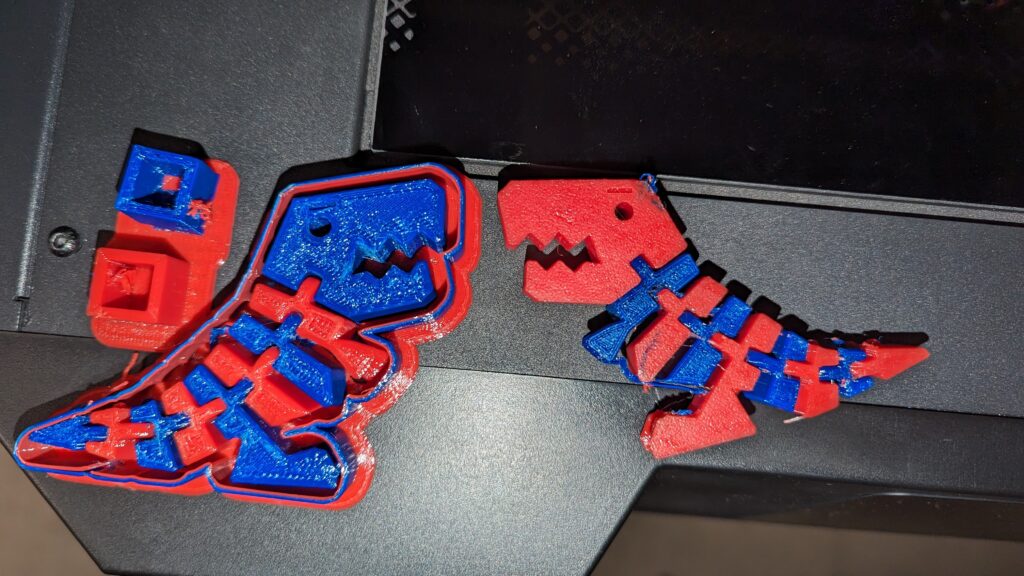Have you ever longed for a 3D printer that blends power, precision, and professional polish? My recent acquisition, the Flashforge Guider 3 Ultra, promised just that. Its all-steel construction, dual high-temp hotends, and robust CoreXY kinematics whispered of high-performance possibilities. Throw in a spacious, fully enclosed build volume, an onboard camera, and ball-screw Z-axis drive, and it seemed like the missing piece in my Maker puzzle. But did the reality live up to the hype? Brace yourself for a deep dive into this ambitious machine.
As you can see from the list of specs, this machine has it all. Support from various slicers, high speed, high accuracy and repeatability, the ability to handle most filaments and a spacious 330x330x600mm build volume that is actually 300x330x600 when using dual extrusion. Both nozzles are unable to reach the full width (X axis) of the build plate.
Printing Performance:
Let’s start off with the good. The very first print, the obligatory 3DBenchy, I got off the machine was great. It was made in PLA, with all the default settings in Flashforge’s proprietary slicing software, Flash print. I left the door and lid open to prevent any heat creeping on the hotend while printing, a common issue when printing a low temp material like PLA in an enclosed printer. It took 42 minutes and looks great, but that is to be expected for basically any printer these days. Every machine I have seen in the last two years has been able to print an equally good Benchy right out of the box. Some like the Bambu Lab X-1 Carbon were even able to do so in less that 20 minutes. However, the point of this machine isn’t world record speeds. It’s reliability, or so I thought.
With this stunning Benchy I was excited and hopeful, so I printed many more test items before I offered to make things for friends and customers. I really wanted to get into at least dual color printing right after the Benchy, so I made a dual-color Flexi-Rexi. This is when I noticed the issues.
I started getting serious stringing between colors. I tried many different things to fix the problem: lowering the temps, increasing the cooling, both increasing and reducing print speed, adding an ooze shield, adding a wipe tower—all with little to no effect on the Flashforge Guider 3 Ultra. Important note: I only change one variable per print and as soon as it would start to fail, I would cancel the print and try again.
After communicating with support for a couple weeks, I had the most catastrophic failure in my printing history. I had changed a few settings according to support’s suggestion, even though I knew it wouldn’t help as I had already tested those parameters. The settings in question were to cut the cool down inactive extruder temps and enable a prime tower and ooze shield at the same time. Never mind the huge waste in material that those two options entail—which my other dual nozzle machine never needed—these were already options I tested, but support treated me like I did not know anything and insisted I do it their way. Here is the result:

This is how my Flashforge Guider 3 Ultra sits currently. During the last print, the stringing built up, grew a molten ball of plastic on the hotends and ultimately ended up destroying the print and the printheads. Flashforge has agreed to allow me to send it back, but MatterHackers has not. Since I bought it through MatterHackers, Flashforge is unable to help me return it.
Software and Usability:
With a very responsive touchscreen, the Flashforge Guider 3 Ultra’s UI is amazing. I was able to do everything right at the printer: calibrate extruder offsets, nozzle offsets from the build plate, align the left and right printheads, and calibrate the resonance of the whole toolhead by using active vibration compensation or input shaping. The only issue that I found was buried in the printer logs, which I dug into when trying to fix my stringing problem. The machine utilizes Klipper firmware in it, perhaps not for the printer’s entire operation, yet I could not find any of that information online. Because Klipper is open source, anyone who uses it is meant to publish their Klipper config.
Features and Functionality:
The Flashforge Guider 3 Ultra had several features on it that were stellar. The high-temp hotends were my personal favorite. I really wanted to print polycarbonate (PC), but never got that far in my testing. The auto calibration of nozzle Z offsets, left and right nozzle alignment, left and right build plate offsets, and the vibration compensation are tremendous value-adds. Coming from using industrial machines like those from Markforged, having all of the extra print speed that vibration compensation can give you was amazing. The potential to extrude dual materials was a really cool feature for me. I don’t print toys or models just because they look good. I print functional prototypes for projects I am working on and useful parts for my car, such as this gear shift knob made with the Flashforge Guider 3 Ultra.

Prototype printed in PLA on the Flashforge Guider 3 Ultra. The final was supposed to be PC to withstand the harsh AZ summers
Maintenance and Support:
Maintenance was easy. Changing the whole hotend was as simple as removing the magnetic cover, flipping a switch, pulling the old one out and adding the new one in. After that, a simple Z-offset calibration was all that was left to get back to printing. As of January 10, 2024, Flashforge does not have spare parts on their site.
Support was a bit tough to deal with. I have eight years experience building 3D printers and working with and maintaining industrial machines, such as those from HP, Markforged, Formlabs, and Stratasys. With my knowledge and experience, I thought I could help. In the company’s defense, Flashforge was doing its job and running through all of the basic support questions like “Did you dry your filament, are printing at the right temps, are you using our slicer, are you using our filament, etc.?” After explaining all of the things I have done, the team still insisted that I use the company’s default settings and add the purge tower and ooze shield. My Raise3D Pro 2, which has two hotends in nearly the same configuration, does not require either of these options.
Overall, I think Flashforge did a lot right with the Flashforge Guider 3 Ultra and is heading down the right path. This machine has so many features that are amazingly useful from the auto-calibrations and the high-temp nozzles to the rugged and sturdy build of the machine, I can’t help but wonder why all of the software is locked down and why the team wouldn’t listen to any of my suggestions.
As it sits, I cannot recommend this machine to anyone. It is just too expensive to have its defining feature, dual hotends, working incorrectly. If the company fixes the dual-nozzle stringing issue, I wouldn’t see any reason not to recommend this machine to someone wanting to get into fast, large-format, high-temp printing.
A more in-depth YouTube video review embedded below:
Subscribe to Our Email Newsletter
Stay up-to-date on all the latest news from the 3D printing industry and receive information and offers from third party vendors.
Print Services
Upload your 3D Models and get them printed quickly and efficiently.
You May Also Like
U.S. Navy Lab Uses 3D Printing to Reduce Tooling Lead Time By Over 90%
The F-35 Lightning II Joint Program Office (JPO), responsible for life-cycle management of the key fifth-generation joint strike fighter (JSF) system used by the U.S., its allies, and its partners,...
Etsy Design Rule Change Reduces Selection of 3D Printed Goods
Online marketplace Etsy has implemented a rule change requiring all 3D printed goods on the site to be original designs. The update to the site’s Creativity Standards states, ¨Items produced using...
Honeywell Qualifies 6K Additive’s Nickel 718 for 3D Printed Aerospace & Defense Parts
6K Additive is renowned for manufacturing sustainable additive manufacturing (AM) powder, and offers a wide portfolio of premium metal and alloy powders that include titanium, copper, stainless steel, and nickel,...
MetalWorm Sells WAAM Systems to Research Institutes in Brazil and Malaysia
Turkish WAAM firm MetalWorm has sold a system in Malaysia and another in Brazil. This is an excellent example of a few emerging trends in additive. Firstly, WAAM was experimented...





































